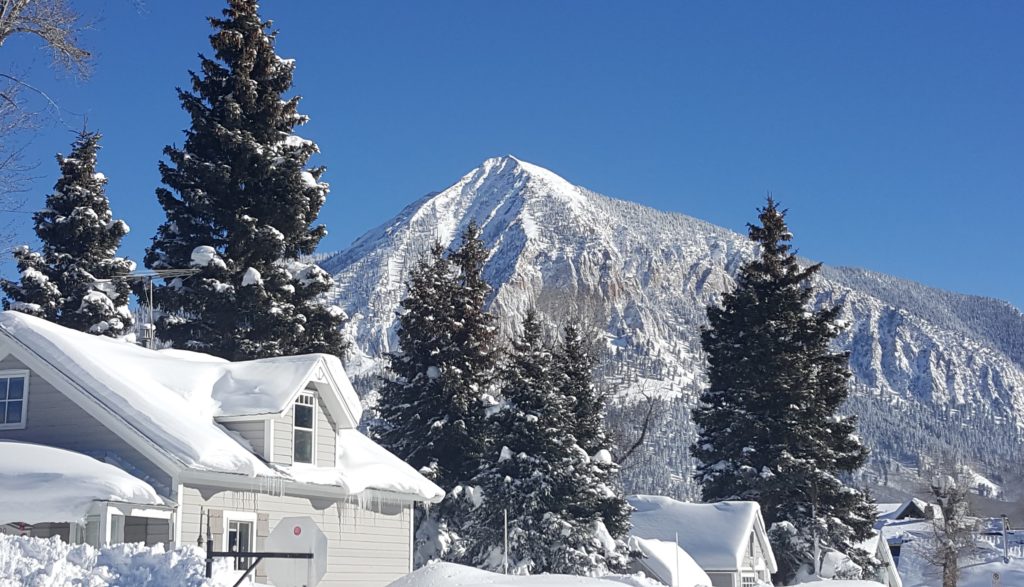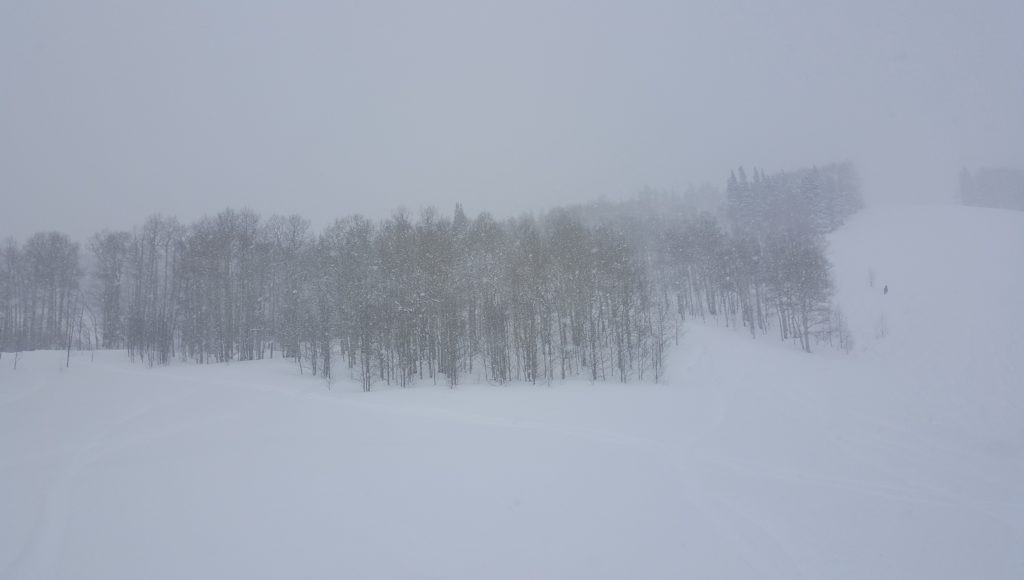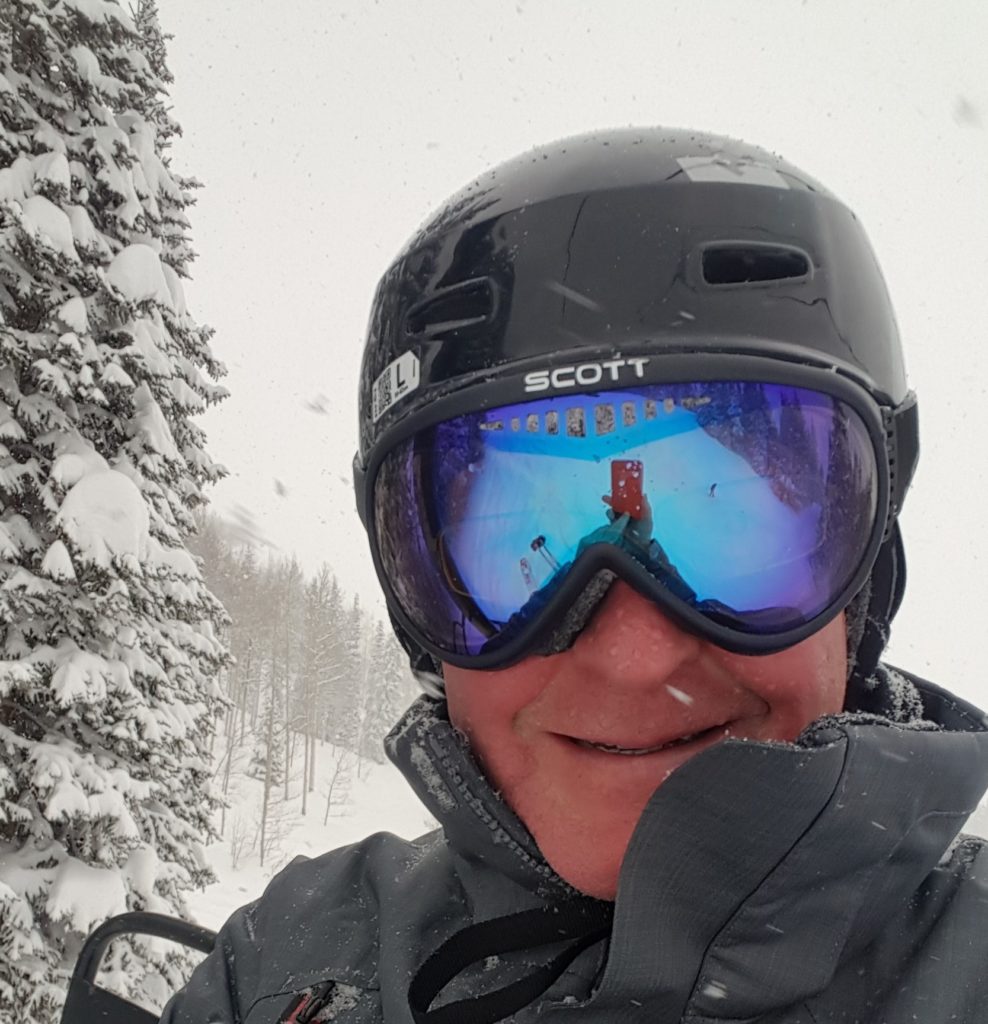Crested Butte, CO, 1/6/2017. A brilliant day after a 4-day storm dumped 4 feet of fresh snow.
Greetings!
All of my students know that I love Tai Chi. That passion infuses my teaching and practice.
One of my other all time favorite things to do is ski. This article describes how Tai Chi and skiing have come together for me, in very beneficial ways.
I started skiing as a child in Northern Michigan. Our “mountain” was a snow-covered sand dune with a tow-rope. That is how we played in Winter.
As a young man, I tackled real mountain skiing – the Sierras, the Rockies, the Alps. As my experience and skills developed, my love of, and respect for, the sport continued to grow.
For me, mountain skiing provides endless challenge – physically, mentally, emotionally. At times, skiing has brought me frustration and pain. Other times, skiing has filled me with joy. (I’ll take joy when I can get it!)
While this article is about how Tai Chi has improved my skiing and helped me ski more comfortably as I age, this information is not just for skiers. The points I cover below are readily transferable to lots of other activities.
So read on and enjoy. And if you find this useful, please share it.
A problem with skiing – pain.
But for aging athletes like me, mountain skiing presents a big problem. Skiing is high impact. It can aggravate accumulated injuries, arthritis, and other conditions. Skiing can hurt!
Beginning about 15 years ago, skiing really began to hurt me, especially my knees and lower back. I would end each day of skiing gulping a big dose of Ibuprofen.
My solution – Tai Chi
Fast forward to today. I’ve just wrapped up several days of mountain skiing in Crested Butte. Conditions made the skiing especially challenging – a 4 day storm dumped over 4 feet of snow.
Challenging mountain conditions – heavy snow, uneven terrain, flat light.
Constantly changing snow depth and texture, highly variable terrain, flat light, and low visibility made for serious hard-working mountain skiing.
While I definitely experienced some muscle soreness, my knees and back felt good. No ibuprofen needed.
What changed over the past 15 years? Lots of Tai Chi.
I could go for hours on how Tai Chi has dramatically helped me and my students— increasing balance, strength, flexibility, reducing pain, helping heal old injuries, replacing stiffness with function and mobility, reducing tension, improving sleep, and much more.
But here I want to focus on Tai Chi and Skiing, specifically—
3 Ways Tai Chi Improved My Skiing
Here they are:
1. Releasing tension
As I teach every beginning Tai Chi student, a fundamental Tai Chi principle is: Relaxing the body at ever deeper levels.
The first challenge in learning to relax tense, tight, contracted tissue is actually perceiving the tension.
Once you can clearly perceive tension, you can apply specific techniques from Tai Chi to relax, release, soften, and open up tight tissue.
The slow, smooth, circular movements of Tai Chi can provide an ideal practice to target and release chronically tense areas – neck, shoulders, back, hips, and more.
Applying this principle to skiing. As I work down the mountain, I now scan my body for areas of tightness, tension, or contraction. Of course, to ski, plenty of muscular contraction essential. It is a very dynamic activity.
But as I scan my body while skiing, I often find lots of places where I am unnecessarily tense or “holding.” Then I release the tension in these places.
What happens when I release unnecessary tension as I skied?
- My turns gain smoothness and fluidity
- My sensitivity to varying terrain improves
- I increase pressure on my downhill ski (to tighten a turn) without extra effort
- It takes a little less energy to ski
Nice result! Now for #2.
2. Connecting the spine to the feet
From the outside, a Tai Chi form can look like a series of smooth, fluid, connected, graceful movements. And good quality Tai Chi can be all that.
But much of what makes Tai Chi a powerful health practice is what you do inside your body. Tai Chi incorporates internal practices or “neigong,” specific and often subtle internal movements that can be difficult to discern from the outside.
Internal practices include maintaining precise biomechanical alignments, lengthening soft tissues, pulsing joints, and much more.
One of the basic internal practices I teach is how to clearly connect the spine to the legs and feet. At a beginning level, we call this “Relaxing the Tailbone Down.”
Basically, you feel your sacrum and tailbone area, release as much tension as you can from there, then allow the tailbone to relax down and forward, just a few degrees.
It can be a subtle move. But when you get it right, you get a clear sense of your spine connecting solidly to your legs and feet.
Connecting the spine to the feet helps you to move the body as a more unified whole, a special characteristic of Tai Chi.
Applying this principle to skiing. As I turn, I focus awareness on my sacrum and tailbone, releasing tension, and allowing my tailbone to relax down and forward, just a little. Then I get a clear sense of my spine connecting right down my leg to my foot and into my ski.
In a turn, I focus the spine connection on my downhill leg and foot, where more of my weight generally is.
What happens when I connect my spine to my feet?
- My sense of connection to my downhill ski increases
- My sensitivity to the varying terrain increases
- My ability to make subtle adjustments to my downhill ski increases
- My ability to increase the pressure on my downhill ski (to tighten a turn) increases
So between releasing unnecessary tension and connecting my spine to my feet, I am able to handle challenging terrain and conditions with a little less effort. I’ll take that when I can get it!
Now on to #3. For me, the really big deal.
3. Maintaining knee alignments and keeping knee joint pressures even
Like many of us who have engaged in years of contact sports and high impact training, I have my knee issues.
I have had surgeries on both knees (cartilage). I have osteoarthritis (OA) in both knees. I have experienced years of chronic knee pain.
Today, my knees feel strong, springy, and are often pain free. Not usually what happens in cases of knee OA. I attribute much of that progress to lots of Tai Chi.
To share this pretty amazing result with other knee pain sufferers, I have developed a program called Tai Chi for Knee Health.
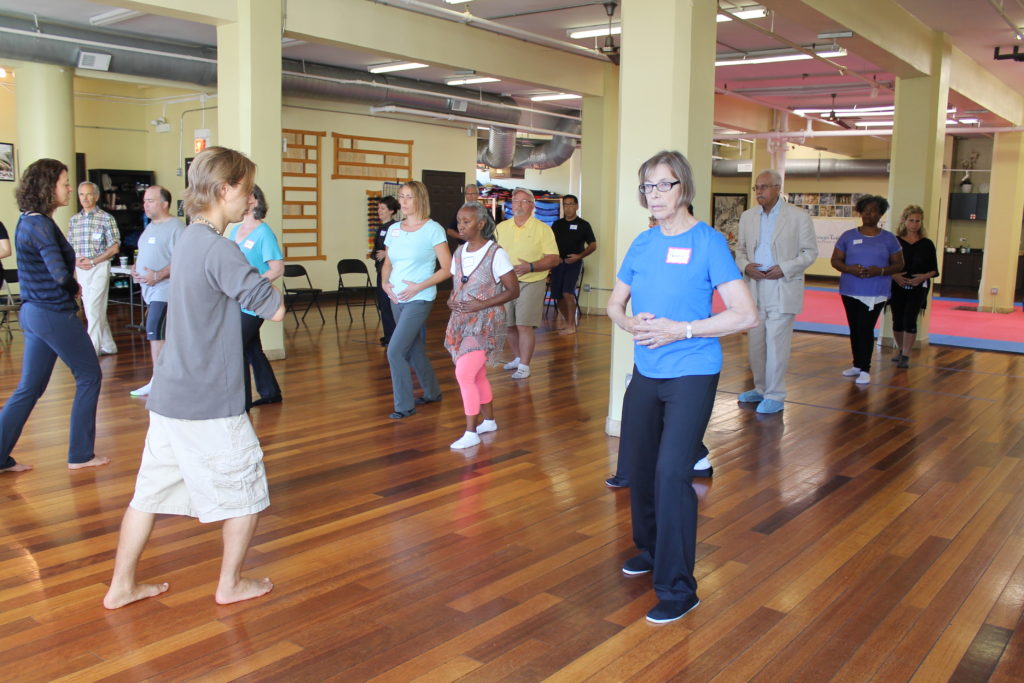 Tai Chi for Knee Health Workshop – Working on knee alignments while shifting weight.
Tai Chi for Knee Health Workshop – Working on knee alignments while shifting weight.
In my Tai Chi for Knee Health System, two key techniques I teach are:
(i) how to align the knee over the foot in a way evenly distributes the pressures inside the knee joint; and
(ii) how to move in increasingly sophisticated ways and maintaining knee alignments and even pressures in the knee joints. (For a short video on these techniques, see the link at the bottom of this report.)
Update: In December 2019, I released the book version of the program, Tai Chi for Knee Health: The Low-Impact Exercise System for Eliminating Knee Pain.
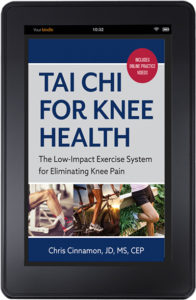
Now available on Amazon in ebook and paperback formats. For more information and to purchase your copy, click here.
Applying this principle to skiing. This required me to maintain constant awareness of my knees as I skied. This was really challenging!
Skiing highly variable mountain terrain with constantly changing snow depth and texture means lots of knee movement in all planes of motion, including split second edge adjustments, balance recoveries, and absorption of terrain changes.
Many of these sudden knee movements can create uneven pressures in the knee joint, including sharp pressures on the sides or front of the knee. This can aggravate OA and other conditions, causing pain, exacerbating existing conditions, and creating new knee problems.
So I work on feeling my knees and making constant adjustments to knee alignments. My aim is to keep pressures inside my knees as even as possible.
What happens when I maintain knee alignments and even pressures in my knee joints?
- no significant knee discomfort during three days of challenging mountain hard skiing
- no apres-ski pain medicine
From years of skiing through chronic knee pain to skiing with no significant knee discomfort. For me, this is a really big deal.
So that’s my story about how Tai Chi has improved my skiing.
Interested in learning more about Tai Chi can help you?
The big point here is that Tai Chi can improve a lot more than skiing. Proven benefits of Tai Chi include:
- Reduced pain
- Improved balance
- Increased leg strength
- Reduced tension
- Improved mental clarity and focus
- Increased mobility and function
- And much more
At Chicago Tai Chi, we focus on helping students move their bodies, clear their minds, and feel wonderful with Tai Chi and Qigong. We offer a variety of learning formats, including:
- Private instruction
- Classes
- Online courses
- Corporate programs
For more information, visit our website at www.chicagotaichi.org
All the best and keep practicing!
Chris Cinnamon, JD, MS
Certified Exercise Physiologist
Head Instructor
chris@chicagotaichi.org
312-203-3557
